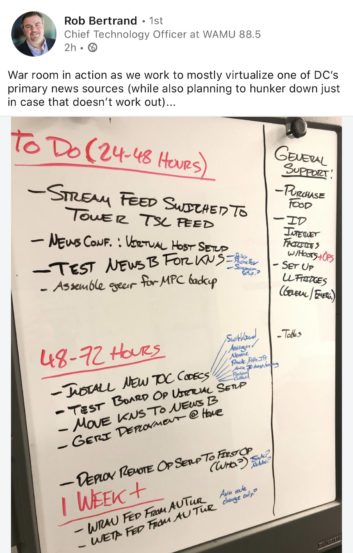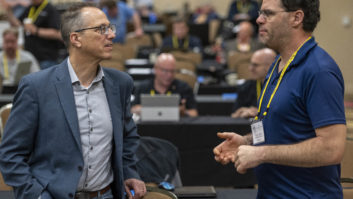 This is how coronavirus response is playing out on the technical operations side of one of America’s leading major-market public radio stations. Rob Bertrand is senior director of technology for WAMU 88.5 American University Radio.
This is how coronavirus response is playing out on the technical operations side of one of America’s leading major-market public radio stations. Rob Bertrand is senior director of technology for WAMU 88.5 American University Radio.
Radio World: What are we looking at in that white board photo?
Rob Bertrand: This is one white board in our technical operations area where we, as a team, are starting to “brain dump” the things we have been tracking individually. The situation is evolving so rapidly that a simple method, albeit crude, seemed like the best idea to keep all of us in the loop. We are figuring out what needs to be done short, medium, and longer term to achieve full remote operation.
RW: How “virtual” can you get, and why are you able to do so?
Bertrand: We plan to achieve 100% virtual operation. It will take several weeks to implement. We are leveraging Axia’s virtual console technology and the flexibility of an all-AOIP plant, combined with remote screen sharing tech like VNC and simple Remote Desktop to remotely control the Wide Orbit players in the studios. We want to keep our studio hardware the same to minimize the learning and configuration curve. Hosts and operators will literally control the same studio they normally do, they will just do it virtually. AOIP codecs like Comrex Access/BricLink/NX and Tieline VIA, as well as our Telos VX phones and PhoneBox screening platform are providing the connective tissue.
RW: What specific technical obstacles have you encountered that you have had to solve or are in process of being solved?
Bertrand: Firewall rules and various network snags are foremost. We are part of American University. While we operate a largely independent network, there are points where we intersect and must coordinate our activity. They are very focused on transitioning to remote learning right now. So weaving our work into that flow has been a consideration, but we’ve been able to accomplish what we’ve needed to together. There are also dozens of “little things” that usually lurk harmlessly in our backlog that are coming more to the forefront right now, at times requiring overnight work. Handling overnight work and dayside staffing with a small team is a challenge. I’m thankful our team is so committed to the work we are doing. Managing across different levels of internet connectivity at the homes of the hosts and board operators involved is also a challenge, but so far we have had good success.
RW: What has the impact been on air talent and on other WAMU staff?
Bertrand: We are learning as we go. There is no master plan for this. People always want to know what’s going on and when it is going to happen. The answers can be pretty fluid right now so patience and trust are key. It’s also critical that we as technologists keep the uneasiness of air staff top of mind. It can be tempting to say “you just need to do X.” But we need to remain mindful that they are dealing with the stresses of being the public name and voice of WAMU, doing that in an unfamiliar manner, and doing so from the otherwise private enclave of their home. Doing all that while also juggling parenting and other family commitments, while trying to deliver meaningful content is a real challenge. Our goal in the technology department is to create the most user friendly solutions we can and to be as responsive to requests as possible. We can’t take anything for granted or force talent into a workflow that isn’t intuitive for them at a time like this, especially. So we are working hand-in-hand with our talent to prototype and then iteratively improve these remote operations in-house, before deploying to home. This isn’t just setting up a remote with talent in the field and the board op back at the station. They need to be able to do it all, amid a rapidly changing environment.
RW: What lessons can other engineers and technical managers learn from what you’ve been doing these past few days?
Bertrand: One of the most important things we are doing is finding time to connect with one another as a technical team on a daily or near-daily basis. We give folks the chance to talk about what’s worrying them personally or professionally, as well as trying to find silver linings or things to celebrate where we can. Lots of people are depending on us to support them. We need to find ways to support one another as we go through this together.
The other piece is understanding that this is a shared learning process. There is no one person with all the answers. A hard timeline is laughable. We are developing rough plans as we go and constantly updating them as we learn more. We are being open with the people we support and underscoring that they are partners in this. We have to approach this work with open minds and a willingness to change plans at a moment’s notice. The more we learn, the clearer things become. But there is no one brilliant mind steering this all. The key is in connecting people with one another in a meaningful way and ensuring we are learning together. The AOIP tech that is enabling all of this is transformational. But it’s not out of the box nor are the answers obvious in a complex news environment. Focusing on people first and plans second has had tremendous impact and will continue to drive as much if not more success than the underlying technology.
RW: Do you think these changes will be permanent in any way?
Bertrand: Some. Yes. We will have better production workflows for our talk shows. Things that we’ve been “meaning to get to” for a long time but are now critical. Will these work from home setups persist? I can’t imagine. But I can imagine a future where we deploy them for snowstorms and the like. Certainly all the different ways we are putting reporters and guests on the air will continue to be useful. Comrex Opal and Tieline ReportIt have been a real lifeline for ad-hoc news gathering and guests. They will no doubt stick around as part of our new arsenal.
RW: What else should we know?
Bertrand: We are also building a disaster recovery setup near our tower facility on the campus of American University just in case we run into trouble at our main facility. Our normal fallback facility is dealing with their own challenges, so we’ve had to improvise another DR location.
We are preparing for remote work, offsite operation, and potentially hunkering down in our facility for an extended period of time. Lots of contingency planning! And understanding that we can’t be too married to any single plan.











